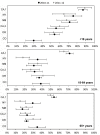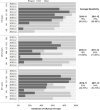Estimating influenza disease burden from population-based surveillance data in the United States
- PMID: 25738736
- PMCID: PMC4349859
- DOI: 10.1371/journal.pone.0118369
Estimating influenza disease burden from population-based surveillance data in the United States
Abstract
Annual estimates of the influenza disease burden provide information to evaluate programs and allocate resources. We used a multiplier method with routine population-based surveillance data on influenza hospitalization in the United States to correct for under-reporting and estimate the burden of influenza for seasons after the 2009 pandemic. Five sites of the Influenza Hospitalization Surveillance Network (FluSurv-NET) collected data on the frequency and sensitivity of influenza testing during two seasons to estimate under-detection. Population-based rates of influenza-associated hospitalization and Intensive Care Unit admission from 2010-2013 were extrapolated to the U.S. population from FluSurv-NET and corrected for under-detection. Influenza deaths were calculated using a ratio of deaths to hospitalizations. We estimated that influenza-related hospitalizations were under-detected during 2010-11 by a factor of 2.1 (95%CI 1.7-2.9) for age < 18 years, 3.1 (2.4-4.5) for ages 18-64 years, and 5.2 (95%CI 3.8-8.3) for age 65+. Results were similar in 2011-12. Extrapolated estimates for 3 seasons from 2010-2013 included: 114,192-624,435 hospitalizations, 18,491-95,390 ICU admissions, and 4,915-27,174 deaths per year; 54-70% of hospitalizations and 71-85% of deaths occurred among adults aged 65+. Influenza causes a substantial disease burden in the U.S. that varies by age and season. Periodic estimation of multipliers across multiple sites and age groups improves our understanding of influenza detection in sentinel surveillance systems. Adjusting surveillance data using a multiplier method is a relatively simple means to estimate the impact of influenza and the subsequent value of interventions to prevent influenza.
Conflict of interest statement
Figures



References
-
- Molinari NA, Ortega-Sanchez IR, Messonnier ML, Thompson WW, Wortley PM, et al. (2007) The annual impact of seasonal influenza in the US: measuring disease burden and costs. Vaccine 25: 5086–5096. - PubMed
-
- Centers for Disease Control and Prevention (2010) Estimates of deaths associated with seasonal influenza—United States, 1976–2007. MMWR 59: 1057–1062. - PubMed
-
- Thompson WW, Shay DK, Weintraub E, Brammer L, Bridges CB, et al. (2004) Influenza-associated hospitalizations in the United States. JAMA 292: 1333–1340. - PubMed
MeSH terms
LinkOut - more resources
Full Text Sources
Other Literature Sources
Medical

